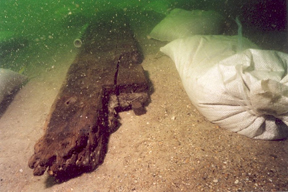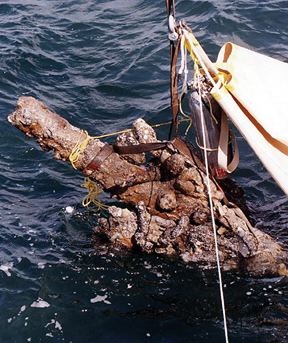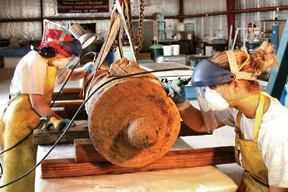|
Feature
Unlocking Blackbeard's Secrets
Megan Sever
 The year was 1717. Europeans were settling the American colonies along the Atlantic seaboard, with port cities such as Boston, Philadelphia and Charleston flourishing. Merchant ships ferried goods, such as linens, weapons and food, between Europe and the colonies, and between the northern and southern colonies. Slave ships delivered thousands of slaves from Africa to the Caribbean and the southern colonies to work in sugar and tobacco plantations. Meanwhile, countless ruthless pirates roamed the shipping waters, plundering and commandeering ships, ports and tons of merchandise.
The year was 1717. Europeans were settling the American colonies along the Atlantic seaboard, with port cities such as Boston, Philadelphia and Charleston flourishing. Merchant ships ferried goods, such as linens, weapons and food, between Europe and the colonies, and between the northern and southern colonies. Slave ships delivered thousands of slaves from Africa to the Caribbean and the southern colonies to work in sugar and tobacco plantations. Meanwhile, countless ruthless pirates roamed the shipping waters, plundering and commandeering ships, ports and tons of merchandise.
Original timbers from the hull of a ship mark what is believed to be Queen Anne’s Revenge, Blackbeard the pirate’s flagship. The timbers, along with other artifacts and ship components found at the wreck, have much to reveal about the lives of 18th century pirates. Photograph is by Julep Gillman-Bryan.
Indeed, with so many valuables being traded across the Atlantic and a lack of a strong colonial government, the American coast became a hotspot for piracy, with the early 1700s marking a “Golden Age of Piracy.” The inlets and sounds of North Carolina’s Outer Banks in particular became a haven for many pirates and outlaws, perhaps none more famous — or infamous — than Blackbeard.
Mysteries and myths surrounding these outlaws abound. The intrepid bad guys of centuries past may evoke fanciful images of plank-walking captives, damsels in distress and bearded, eye-patched men with parrots on their shoulders drinking rum. But now, new research on what is believed to be Blackbeard’s flagship is bringing details of the pirate’s life to light. Geoscientists are helping by using geochemical and geophysical tools to help excavate the ship and identify the origins of the ship’s components and artifacts.
A pirate’s life for me
A large man with an immense black beard, Edward Teach (or Thatch) was thought to have begun a life of piracy around 1713, sailing with another notorious pirate, Benjamin Hornigold. Blackbeard, as Teach became known, was said to frighten his opponents just by looking at them. He wore two swords and several bandoleers stuffed with pistols and knives, according to David Moore, an underwater archaeologist at the North Carolina Maritime Museum in Beaufort. To add to the intrigue and fear, rumor has it that Blackbeard wove gunpowder-laced wicks into his beard and lit them when he went into battle.
By 1716, Blackbeard commanded his own ship with a large crew, and was sailing the Atlantic seaboard and the Caribbean Sea alongside Hornigold. By November 1717, however, Blackbeard and Hornigold had parted ways, as Hornigold took a pardon offered by the British monarchy to pirates who agreed to retire, Moore says.
Blackbeard did not take advantage of the amnesty, Moore says, and instead overtook the French slave ship La Concorde in the eastern Caribbean. He recommissioned her, named her Queen Anne’s Revenge, and set sail throughout the Caribbean and up the Atlantic seaboard. Queen Anne’s Revenge was Blackbeard’s flagship, right up until he ran her aground on a sandbar in 4 meters (12 feet) of water — some say intentionally — in Beaufort Inlet off the coast of North Carolina in June 1718.
Reports suggest that Queen Anne’s Revenge took awhile to break apart, allowing the pirates time to get everything that they wanted off the ship, says Mark Wilde-Ramsing of the North Carolina Office of Archaeology. Blackbeard and his 300-plus-member crew scattered to the countryside following the wreck, he says. Six months later, Blackbeard was killed by an armed contingent sent by Virginia’s governor in North Carolina’s Ocracoke Inlet.
Meanwhile, Queen Anne’s Revenge lay on the seafloor, buried under sand for the next 278 years, Wilde-Ramsing says. Then, in 1996, after hurricanes had scoured away some of the sand covering the shipwreck, divers from Intersal Inc., a private shipwreck recovery company, located what researchers believe to be Blackbeard’s flagship, resting in 6.7 meters (22 feet) of water. Recognizing the significance of the find, Intersal turned the site over to the state of North Carolina for examination, says Wilde-Ramsing, who is now leading the site’s excavation.
Shipwrecks are essentially time capsules, capturing a single moment in time, Moore says — in this case when Queen Anne’s Revenge went down, the second week of June 1718. What items the pirates left behind indicate what they thought was of no use, or was too large to carry as they scattered into the countryside, Wilde-Ramsing says. Comparing what was found on Queen Anne’s Revenge to what has been found on other pirate ships that went down around the same time — such as Whydah, which sank off Cape Cod with all aboard — reveals what the pirates probably took with them and thus considered of value.
What was left aboard also reveals much about day-to-day life, Wilde-Ramsing says. Remains of food, such as animal bones and oils in jars, elaborate on what pirates ate, while ceramics, as well as pewterware plates and utensils, suggest how they ate. Medical equipment tells about health issues the pirates may have encountered, and navigational instruments hint at their technologies.
Looking at the life of a pirate provides a different view of society than is usually seen in history books, says Marcus Rediker, a pirate expert at the University of Pittsburgh — the history of working-class people who didn’t leave a written history of their own. “Set aside the sensationalism and romanticism that surrounds pirates and ask a different set of questions, such as what would have been their reasons for choosing that life,” he says. Pirate shipwrecks can tell us a whole lot about the pirates’ lives, he says.
Tracing origins
The believed site of Queen Anne’s Revenge, on first glance, is just a pile of rubble, with a mound 7.6 by 4.6 meters (25 by 15 feet) composed of anchors, cannons, ballast stones and remains of the wooden hulls. Underwater magnetometer surveys have revealed that the shipwreck site is fairly compact (about 700 square meters), with artifacts staying close to the mound.
 |
| Archaeologists pull up a cannon encrusted with sea creatures and 278 years’ worth of corrosion from the supposed wreck of Queen Anne’s Revenge. |
 |
| After more than a year in a desalting tank, researchers were able to expose the cannon to air to examine it. Archaeologists have already located 25 cannons at the wreck site. Photographs are courtesy of the North Carolina Department of Cultural Resources. |
This compactness indicates that the 300-ton ship deteriorated in place and was not sunk by a storm, Wilde-Ramsing says, which matches how historical documents describe the wreck. Although archaeologists have only excavated a small portion of the site so far, he says — probably less than 10 percent — they have recovered loads of artifacts that all point to this wreck being Queen Anne’s Revenge.
More than a dozen different researchers from varying fields, including geologists, biologists, dendrochronologists and of course archaeologists, have been working on the artifacts, Moore says. Each piece of evidence gives researchers a glimpse into life in the early 18th century.
For example, the 25 discovered cannons, as well as cannonballs and lead shot (small “bullets”), give a glimpse of naval warfare. Because the weaponry and other artifacts are composed of metals, James Craig, an ore mineralogist at Virginia Tech, has joined the excavation efforts. So far, he has identified artifacts of iron (cannons, nails), copper and tin (alloyed in the pewterware), zinc (in navigational instruments), lead (in lead shot), mercury (in the medical syringe), silver (in ornamental clasps) and gold (free flakes).
Craig traced the lead shot as well as the pewterware to “the Old World,” either England or the Mediterranean, he says, through lead isotope data. The ratio of the four isotopes of lead is dependent on when and where the lead formed. As the ratio of the isotopes within an object change with time, the isotope analysis can give a virtual fingerprint for a metal’s origin — in this case, the provenance is European, as would be expected for Queen Anne’s Revenge.
Craig also examined the gold grains, to see if they could be traced to a particular location. He says that the gold was found in a “placer” environment, probably in West Africa, though the grains can’t tell him much more than that. Gold dust was a form of currency in the 1700s.
Like the lead shot, the iron of the cannons came from the Old World, Craig says. Inside some of the cannons, in addition to traditional cannonballs, Craig found “odd stuff,” he says, including leather, broken glass, wire, spiked cannonballs and other “nasty stuff.” This composition points toward the ship being a pirate’s ship, he says, as governmental navies would have only used “normal” cannonballs. Pirates would have used the other materials at close range to damage the rigging and sails of ships they were trying to capture, Moore says. Removing or severely damaging the rigging and the men operating that rigging gave the pirates “a much easier prize to capture,” he says.
Researchers also have been able to analyze wood fragments to trace the ship to a European origin and to date the ship, Wilde-Ramsing says. Additionally, other botanicals on the ship, such as acorns and papaya cores, are helping to trace where the ship has been, says Lee Newsom, an archaeologist and wood anatomist at Pennsylvania State University.
Newsom examined 32 fragments of the ship itself as well as some wooden artifacts. Some 85 percent of the ship consisted of white oak, a species prevalent in Europe, she says, but which also existed in North America. The ship also consisted of live oak and Scots pine, which were fairly confined to the Mediterranean and Europe at that time. And one of the anchors was made of black olive, which was only found in the Mediterranean. Putting these woods together, again, points toward a European origin, she says.
To try to date the ship, Mike Bailey of Queens University conducted tree-ring analyses, but did not have enough rings to get an accurate age, Wilde-Ramsing says. Similarly, Chris Martens at the University of North Carolina in Chapel Hill and Ann McNichol at Woods Hole Oceanographic Institution, have radiocarbon dated the timbers, and though radiocarbon dating is not very reliable at such young ages, found that the trees dated to the late 1600s, Wilde-Ramsing says. That’s about the age that would be expected for the trees that were harvested to build the ship. Altogether, he says that the wood evidence “is consistent with what we expected” about when the ship was constructed.
Another line of evidence researchers have is the ballast stones, which they hope can track the ship’s route, from France through West Africa, to the Caribbean and finally to the United States, says Craig, who along with William Miller, an environmental scientist at the University of North Carolina in Asheville, and Jack Callahan, a retired geologist from Appalachian State University, has been examining the ballast stones. If the ship picked up ballast stones at a location where Blackbeard was known to have visited, it would provide further evidence that the ship is actually Queen Anne’s Revenge.
A ship the size of Queen Anne’s Revenge would have carried 30 to 40 tons of ballast stones (about 30,000 to 40,000 rocks weighing about a kilogram each) to keep the ship upright, Craig says. Researchers have already recovered more than 1,300 individual ballast stones from the wreckage, Miller says.
Ballast stones would have been thrown overboard and picked up at each port, Miller says, making it somewhat difficult to trace them. “It’s kind of a shot in the dark,” Wilde-Ramsing adds. However, the researchers have characterized the rocks through geochemical analyses, magnetic signatures and isotopic analyses, and found most of them to be volcanic rocks, with traces of sedimentary rocks, such as would be found in Caribbean island arcs, Miller says.
The ballast stones are not the type of rocks that would have been found in Europe or Africa, he says, which “helps us narrow the field.” So far, though, the researchers can’t determine any specific island from which the stones came, he says. Both Craig and Miller hold out hope that further research will help them pinpoint the rocks’ origins they say.
Challenges at sea
One of the major challenges of underwater archaeology is that once objects are brought to the surface, they will simply disintegrate as encrusted salt reacts with oxygen, Wilde-Ramsing says. Iron will crumble, and wood will shrink and crack. So the researchers must pull out the artifacts carefully and store them in water-filled tanks for periods of months to years to precipitate out the salt, before they can examine the artifacts. A large cannon, for example, requires two to three years in a big tank to desalt. A cannonball takes several months.
The fact that most of the artifacts are covered with remnants of their time underwater — such as mollusks and other “encrusting” animals, as well as cemented sand and corrosive minerals that form on the metals — provides yet another challenge, Wilde-Ramsing says. Much of what they pull up is simply “amorphous blobs,” or “conglomerates” of encrusted materials, he says.
Recently, the researchers have begun X-raying these conglomerates to see what’s inside months before they can actually dissect them to separate out the artifacts from their matrix. Inside the conglomerates that have not been dissected yet, they have found more of the usual — ceramics, glass, cannonballs and trade beads, Moore says. But they have also observed what look like slave shackles, he says, “which is very exciting,” because the researchers would expect to see some evidence of the slaves if the ship were originally La Concorde, but until now they had not seen any such signs.
Another challenge is managing the high costs of such an operation, Wilde-Ramsing says, even though most of the researchers working on the project are volunteering their time. New funding this year, however, is allowing the researchers to begin a full excavation starting this month, providing the hurricane season allows it, he says.
Reality check
Unfortunately for the researchers, nothing in any of the artifacts explicitly says “Blackbeard was here” or “this was Queen Anne’s Revenge,” Craig says. The dates of the artifacts add up, however, with the cannons manufactured in the late 1600s or early 1700s, the wood from the late 1600s, and a medical syringe found onboard matching those used for treating syphilis at the time. Ceramics and glassware that bear inscriptions from France and England date to the same period. Furthermore, archaeologists found a small bell, less than half a meter tall, that has a religious inscription and the year 1705, which is the right time frame for the original La Concorde.
Still, the bell’s inscription is not in French (it is probably in Spanish or Portuguese), nor does it say La Concorde. Likewise, none of the pewterware is inscribed with the name of the ship or Blackbeard’s name. And while there is no silver, nor any other telltale artifacts that can be directly tied to the ship’s crew, it’s not surprising, Moore says, as the pirates had time to take any personal items and valuables off the ship.
The “preponderance of evidence” indicates that this wreck is indeed Blackbeard’s flagship, Wilde-Ramsing says. “We’ve put everything together — artifacts, politics, history, such as how many vessels went into that inlet, what type of vessels went into the inlet, the fact that it’s a heavily armed vessel, and documents detailing where Queen Anne’s Revenge went down — and it all adds up,” he says. Queen Anne’s Revenge is the only known shipwreck of the early 18th century in this location that matches the evidence.
Excavations at shipwrecks, such as the one at the site of Queen Anne’s Revenge, “are incredibly important,” says Rediker of the University of Pittsburgh. Practically anything researchers find, he says, is helpful to figuring out the true history of pirates, “which I think is so much more fascinating than the mythology Hollywood can create.”
Sever is a staff writer for Geotimes.

 Subscribe
Subscribe

